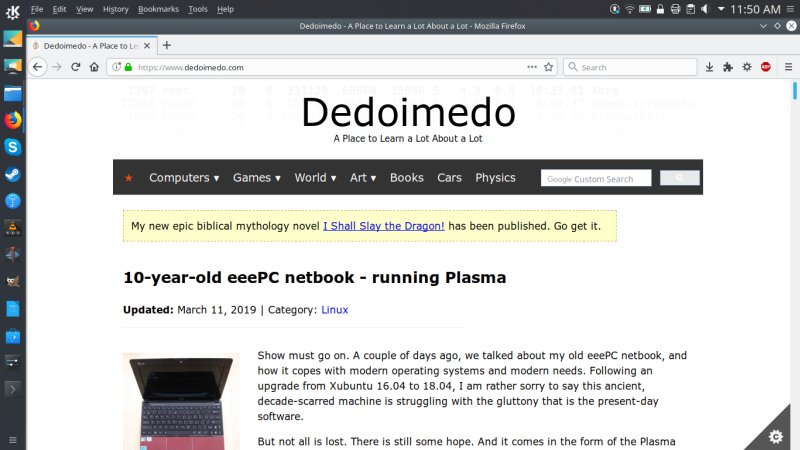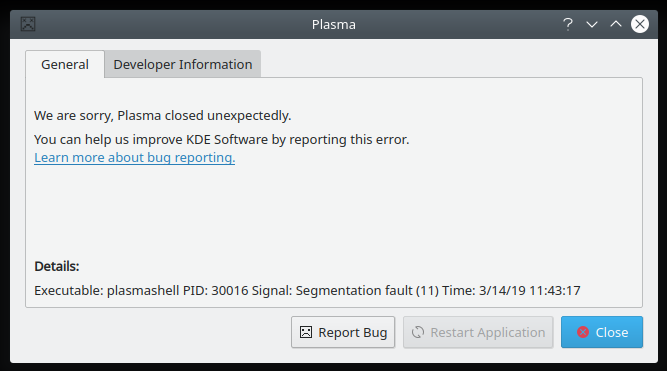Updated: April 24, 2019
Let's spice things up, shall we. A few weeks ago, I upgraded the Trusty instance on my Asus Vivobook to Bionic, doing this via two consecutive updates in the same day, both rather successful. Then, I installed Unity as the desktop environment of choice, and did some basic testing, to see how well everything works. And well work everything (almost, 99%) did.
Then, I thought, what about Plasma? After all, it is my desktop environment de jour, and I'm using it in my production setup on the Slimbook laptop. So it only makes sense to see what is going to happen if the same exercise is applied to this device. Plus a twist. Hence the article. Read.
Plasma installation
A simple one liner will do. I actually installed the full Kubuntu desktop - sudo apt-get install kubuntu-desktop thingie whatnot. So yes, please note that this one liner will also install Kubuntu's GRUB (black instead of aubergine for the background color), and Kubuntu's splash - coruscating blue outline (plasma I guess) rather than Ubuntu's more orange-white glow. Tiny details, but if you're extremely aesthetically minded, you need to be aware of this.
I let the command run, I selected SDDM as the login manager - this is very similar to what I showed you with my eeePC netbook experiment. A few minutes later, I logged out, logged back in, and there, behold Plasma desktop!
In essence, this is Plasma 5.12 LTS, intended to be supported for full five years, and this goes hand in hand with the Ubuntu long-term release model. So this was instantly familiar - and predictable - and pretty much exactly what I already have configured on the Slimbook. Perhaps boring even. All right then, we ought to make it more interesting. How about using an Unity-like layout to keep the nostalgia juices flowing?
Make Plasma look more like Unity
This ought to be a fun escapade. After all, Plasma is a highly flexible, customizable desktop environment, and there's very little you can't do with it. Creating a vertical panel (launcher) layout with a whole-screen overlay menu should be a breeze. Get it? Breeze!

I started by creating a default panel top of the screen, reduced its height, then removed the task area. I then created a second panel, placed it on the left side, added the application menu launcher plus the icons-only task manager. I adjusted the width of the top panel so that the chunkier, wider vertical one would display fully, and this is important in order to have a nice big icon. I did need to move the widget button around, and this was a bit frustrating - the whole drag 'n' drop is somewhat clunky, but I managed.




Global menu & buttons
I tried using the global menu widget, and largely, this works fine - but there's a slight delay creating and then deleting the menu when you switch context between applications. Unity does this more smoothly. You also have window decorations, so moving the buttons to the left side does not make sense, although it does feel logical with the left-side panel setup.

Software and such
Well, Plasma didn't use any of the Gnome or Unity settings, so I had to start from scratch in this regard, including various file manager shortcuts and alike. I also had to add the home directory places, like Downloads, Documents and the rest. All in all, this took about 10-15 minutes to sort out, so that ain't too bad. I also changed the font color to black, and tried Ubuntu fonts instead of Noto.
Most of what rests below Plasma remained functional, like the printer setup. But I couldn't Samba without the necessary tweak, and even then, no Samba timestamps for you! I was able to use my smartphones without hiccups, and there were no other problems that would somehow put Plasma in crosshairs. In general, the underlying system is robust, and the desktop doth not interfere.
Resources & performance
As always, Plasma is phenomenally fast. Light, lithe, elegant. It's even a tad more responsive than Unity, although that one is no slouch by any means. The differences will be almost imperceptible to the ordinary user, but since I'm THE user, then I do perceive it, and it's quite small. Given that I've never done any cleaning or pruning or anything, the machine runs as light as the first day I got it. Very cool.
Memory usage stands at 500 MB - similar to the Slimbook Pro2, and the CPU does not make too much noise. About 1.5% on idle, which is significantly better than what we've seen with other desktop environments. Plasma truly stands out in this regard.

Battery life
Really, really good. Supremely good. First, the battery has only deteriorated to 90% its original charge over the period of five and a half years. I also noticed the same thing with the little Asus eeePC. Excellent quality in this regard. Second, you get a lot of juice even with moderate loads, and with brightness reduced to 50%, the numbers really go up. At 90% capacity, 80% charge, I still had about 3 hours and 50 minutes left. This translates to about 5 hours. With full brightness, you get 4 hours.
Alas, I don't have the original numbers from Trusty to compare to. We can only compare to what we currently get with either Windows 8 or Unity, and for the latter, that's 4 hours (with 100% brightness). The two are virtually identical. I will do some more testing, and try to find old screenshots from five years ago, to see what kind of battery values I was getting back then. I'll also look into the Windows side of things, because typically, Windows has very solid battery results, comparable to Plasma. More on this in the future.


All is quiet on the Western front ... except ...
I did encounter a couple of problems. One-time issues, but they annoyed me ever so. One, while tweaking the system area (making icons permanently shown or hidden), I got the plasmashell process to crash. How very naughty. This issue has been around for a while, so I'd expect it to be fixed, fixed, fixed!

Then, the system supposedly didn't have enough free memory to report the problem. What? I checked the system resources, and at this point, there was still 350 MB of free RAM, plus 2.5 GB in buffers/cache, which should be available and usable, plus there was no swapping at all (that's 4 GB more, if needed). Very weird. This smells like a bug of its own - either way, completely unacceptable for a system that does nothing, because at this point, I haven't even launched any applications or done any work to even justify this sort of dialog.

I also encountered a weird visual glitch - the top panel comes with a sort of dented right border. It's supposed to be aligned fully into the top-right corner, but then there's this 5px gap or so. I played with the panel quite some, and noticed this happens if you don't maximize the panel to the full screen width. Then, any change in the width using the drag handles causes the right edge to sort of get misplaced and jagged. Then, it's suddenly gone. Not sure how or why.

Top right corner, what?
Conclusion
The more you use a system, the more you detect potential problems. Mind, I haven't come up with seven Slimbook combat reports for no good reason (so far). That said, Trusty gave me no grief at all, so I am a bit miffed that there were some glitches, both with Unity and Plasma here. Mostly isolated problems that did not recur, so these could just be the ghosts after the upgrade. Nothing major, and overall, 'twas a good test and post-upgrade experience.
The good side of the coin is - the Plasma desktop environment is stylish, you can run it in the nostalgia mode if you like, it's super fast, it's super efficient, with great responsiveness and low battery usage, it works well, and offers a wealth of goodies. This is definitely a setup I'm comfortable with, and I can use it for important, real productivity tasks. Now, the ideal state of things would be Trusty Forever, but that's not possible. Looking across the entire spectrum of operating systems, the golden days of stability and quality seem to be behind us. But while perfection may be half an asymptote away, my Vivobook running Plasma is a very sensible solution for everyday needs. In a way, Plasma has proven itself once again. And on that note, we end.
Cheers.